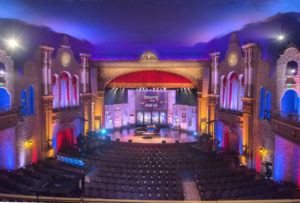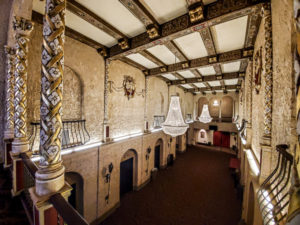Stefanie H. Weill Center for the Performing Arts Celebrates 20 Years of Revitalization
Sheboygan leaders invite patrons of the arts to come stay “a Weill”
For nearly a century, Sheboygan’s performing arts scene has been anchored by its theater located at 826 North 8th Street. Constructed in 1927-28 for the Milwaukee Theatre Circuit of Universal Pictures Corporation, the original cost was $600,000. Over the years, Hollywood and New York performers, like Abbot and Costello, the Marx Brothers and Duke Ellington, graced the stage. Warner Brothers purchased the theater in 1930 and operated it until 1966, when it was sold to Marcus Theaters Management Company. Marcus eventually created two single-story theaters within the building, ultimately closing in 1992.
With the closure of the theater, the heart of the Sheboygan arts scene had essentially ceased beating—until October of 1996 when the Weill Center Foundation, Inc., a not-for-profit 501(c)(3) corporation, was established and became the driving force in the preservation and restoration of the Sheboygan theater.
“It is such an important cog in the community, and I like to refer to it as a hub—we are right downtown,” says Executive Director Katy Glodosky. “It’s not just about the entertainment in the venue, but the experience that surrounds it. We rely on the ability to gather people together for these shared experiences and there’s just something so magical about a group of people experiencing the same thing … shared experiences allow us to connect with each other in such an important, meaningful and memorable way.”
Following an extensive fundraising and remodeling effort, the group brought Sheboygan’s premier historic movie palace back to life. Today the theater is home to several local performing arts groups, plus presents its own series of live performances and movies. This year embarks upon a 20th anniversary celebration of that extensive renovation, completed in 2001.
The final renovations to the “Sheboygan Theatre” were made possible by the Stefanie H. Weill Charitable Foundation, established in 1966, and as such, the theater was given the name “Stefanie H. Weill Center for the Performing Arts.”
 Born in 1906, Stefanie and her husband, John Weill, immigrated to the United States in 1941 from Vienna, Austria. Upon arriving in Sheboygan, Stefanie became a member of Pine Hills Country Club, served on the board of directors of the John Michael Kohler Arts Center, and was active in Friends of Sheboygan Symphony and many other community and civic organizations.
Born in 1906, Stefanie and her husband, John Weill, immigrated to the United States in 1941 from Vienna, Austria. Upon arriving in Sheboygan, Stefanie became a member of Pine Hills Country Club, served on the board of directors of the John Michael Kohler Arts Center, and was active in Friends of Sheboygan Symphony and many other community and civic organizations.
“From all the documents I have referenced in the past, her gift is really made to preserve the theater and make it accessible for all ages to enjoy,” reflects Glodosky. “I think she was really about bringing this space to the community that could serve entertainment purposes. And I think she had a real consideration for arts and culture, so to continue her legacy, our goal is to continue to be collaborative and impactful, working together to achieve common goals, but then also continually positively impacting downtown Sheboygan, driving the traffic to the stores and the restaurants, and supporting our neighbors and our other local arts organizations.”
There is a strong sense of community pride and nostalgia when it comes to the Weill Center, explains Weill Center Foundation Endowment board member Rich Balge.
“I think the importance is that not only did we restore a kind of gem, a theater gem, if you will,” he says, “but there were so many people who were behind it, who had memories of going there as kids when it was still functioning as a theater before it shut down. There is a sense of nostalgia because [people] remember going to the movies there as kids, or going to see performers as kids, when it was open a number of years ago.”
As an ardent supporter of the Sheboygan Symphony—the longest-standing continually performing symphony in the state of Wisconsin—Balge says it’s not only wonderful to have a permanent home for the symphony, but because of the Weill Center, all genres of entertainment are accessible by the community and visitors alike.
“By creating and restoring that venue, we were able now to bring in anything from obviously classical to rock to country to stage opera,” he says.
As the center’s 20th anniversary season kicks off this month, Glodosky says it’s a season of celebration with a lineup like never before.
“We were very thoughtful in our approach to programming and really wanted to expand and diversify what we were offering to attract an even broader audience.”
The year-long celebration kicks off September 1 with Josh Turner. Them Coulee Boys, Oakridge Boys, the State Ballet Theater of Ukraine, Spamilton, Broadway’s An Officer and a Gentleman, BritBeat – A Tribute to the Beatles, Dean Z’s Rockin’ Christmas and a slew of other live performances complement the symphony’s appearances. There are also several chances to see movies that have captured our hearts over the years on the theater’s big screen.
Doug Pelletiere, executive vice president of human resources at Sargento Foods and Weill Center board member, says that the energy and excitement surrounding the Weill Center and its future is important to him. He not only has a deep appreciation for the arts, but also for what a healthy arts scene means for the future of the community overall and to stakeholders in the business community.
“I felt it was very important that I participate in some way to help make sure that we have a community that attracts and retains talent, and I think a vibrant arts scene is critical to that,” he explains. “I don’t want to use the term revitalize, because I think the Sheboygan downtown area is beautiful and there’s been a lot of effort there in recent years to really make it a destination choice. But certainly, I think the Weill Center itself can be a cornerstone for that downtown development.”
As a result, the center’s stakeholders are conducting a feasibility study to learn more about the potential to develop the nearly half block of vacant property the center owns.
“This space could potentially be a new flexible and adaptable venue, like a black box theater to provide entertainment, cater to our community group’s theatrical performances, provide a nightlife option/dance scene, and [host] cabaret performances from emerging artists ranging from country and bluegrass to pop and hip-hop, and more,” explains Glodosky. “It would definitely have its own style and be a destination in itself. We plan to share more with the community later this fall.”
“I think there is an appetite from other community and business leaders I’ve spoken to, to see the Weill Center expand and explore new possibilities,” adds Pelletiere. “I’m excited and there’s so much energy right now around the Weill Center from Katy through the entire board; I feel the potential is unlimited.”
It’s an “all-in” feeling throughout the downtown area when it comes to the Weill Center, from the center’s staff, volunteers and donors, to the area businesses and hotels welcoming visitors and working together to make Sheboygan a destination. The theater receives no public funding but relies solely upon the earned income and donations from corporations, foundations, families and individuals, plus the efforts of more than 100 dedicated volunteers.
The importance of the arts in our lives was certainly brought to the forefront over the past year and a half, when we were unable to join together and celebrate all the amazing moments and memories a live experience brings to each of us.
“I think that absence of being able to do some of the things that we took for granted has really made us appreciate more of what we have,” furthers Pelletiere. “And certainly, I’m excited to get back to the theater. I’m excited to get back to live performances.”












Leave a Comment